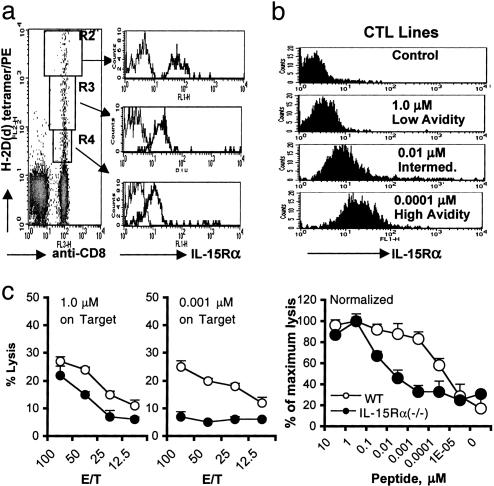Fig. 3.
High-avidity CD8+ CTLs express higher levels of IL-15Rα, resulting in long-lasting memory CTLs. (a) Cells from the pooled spleens of three to four mice immunized with vPE16/IL-15 were stained with anti-CD8 and P18-I10 tetramer. IL-15Rα expression levels were measured for CD8+ T cells gated by the brightness of tetramer staining. Thin lines represent isotype control antibody. Three repeated experiments showed consistent data. (b) CD8+ T cell lines were raised by in vitro stimulation with different concentrations of P18-I10 in the media containing 50 units/ml IL-2. Cells grown in 0.0001, 0.01, and 1.0 μM peptide are designated as high-, intermediate-, and low-avidity CTL lines, respectively. The levels of IL-15Rα in CTL lines were measured 6-8 days after restimulation. Four repeated experiments showed consistent data. Data in Fig. 9 indicate that a high-avidity CTL line shows enhanced proliferative responsiveness to IL-15. (c) On day 17 after the immunization with vaccinia expressing ovalbumin, CD8+ T cells from the pooled spleens of three mice per group [B6 or IL-15Rα (-/-)] were restimulated with 1.0 or 0.001 μM of the dominant epitope SIINFEKL peptide for 1 week. (Left) Functional activity of CD8+ CTLs against target cells pulsed with 1.0 or 0.001 μM of the peptide was measured by 5h 51Cr-release assay. (Right) CD8+ T cells were stimulated with 0.01 μM peptide, and lytic activities against target cells pulsed with different concentrations of peptide were measured. Data presented at Right were normalized to the maximum lysis to compare avidity independent of magnitude of lysis and show mean ± SEM of triplicate assays. Data were consistent in two repeat experiments. E/T, effector-to-target cell ratio.

